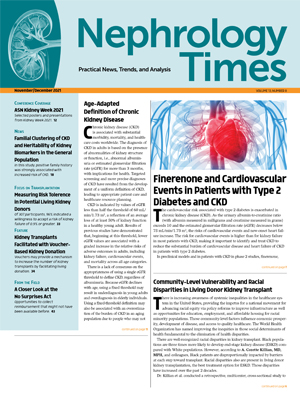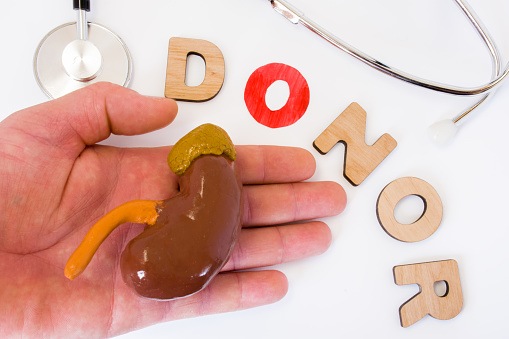
In the face of a shortage of deceased donor kidneys, coupled with the superior outcomes associated with living donor transplants, the transplant community is pursuing strategies designed to increase living donor kidney donation. The surgical risks associated with donor nephrectomy are low; nevertheless, research continues to quantify the risk of postdonation kidney failure. Transplant providers aim to limit the harms to candidates for living kidney donor (LKD) donation per the ethical principle of nonmaleficence. The cornerstone of donor evaluation is the consent of the LVD to the potential harms
The 2017 Kidney Disease Improving Global Outcomes (KDIGO) guideline for LKD evaluation and the subsequent KDIGO commentary on the guideline represent the current state of donor informed consent. The process involves disclosing extensive data required by United Network for Organ Sharing policy. According to Carrie Thiessen, MD, PhD, and colleagues, the policy creates a unidirectional flow of information from physician to patient.
Enhanced informed consent tools can improve patient engagement. The researchers proposed an approach that would center on the donor ,and developed tools to enhance understanding of the risk among donors and facilitate discussions with providers about risk acceptance. The tools include a novel visual aid designed to measure potential donor’s risk tolerance to postdonation kidney failure and to assess whether the closeness of the relationship to the intended recipient altered willingness to accept risk.
The researchers conducted a cross-sectional analysis of donor evaluations at the time of enrollment into a longitudinal mixed-methods study between November 2014 and February 2016. Results of the analysis were reported in the American Journal of Kidney Diseases [2021;78(2):246-258].
The analysis included data from three kidney transplant centers in the United States: Northwestern University (Chicago, Illinois); the University of Pennsylvania (Philadelphia, Pennsylvania); and Yale University (New Haven, Connecticut). Eligible participants were English-speaking adults presenting for in-person living kidney donor evaluation. The outcome of interest was participant willingness to accept postdonation kidney failure.
Willingness to accept postdonation kidney failure was measured using the Donor-Specific Risk Questionnaire (DSRQ), a dot matrix visual diagram. Associations between risk acceptance and data from social science instruments were assessed using multivariable logistic regression models.
The study enrolled a total of 312 potential LKDs (86% response rate). Following exclusion due to language comprehension barriers, insufficient time, a missing survey instrument identified following conclusion of the interview, and two difficulties related to the audio recording, the final quantitative analysis cohort included 307 participants and the final qualitative analysis included 305 participants.
Eighty-four percent of the participants were White, 61% were women, 70% were married, 85% were employed, and 57% had an annual household income of >$65,000. Self-reported scores on the 12-Item Short-Form Health Survey (SF-12) were slightly above the US adult average of 50 for both mental and physical health (54.4 and 56.5, respectively). Fourteen percent of the participants were planning to donate via a paired exchange program; the others expected to donate directly to their intended recipients. Sixteen percent had been evaluated previously at another transplant center.
Most of the participants responded they “strongly agree” or “somewhat agree” with the statements of willingness to accept a 0.9% chance of kidney failure if they donated their kidney (80% and 11%, respectively). Another 4% “replied “neither agree nor disagree,” 1% replied “somewhat disagree,” and 4% responded “strongly disagree” with the statement.
In multivariable analyses, participants who were older (odds ratio [OR], 0.98; 95% confidence interval [CI], 0.96-0.99), female (OR, 0.54; 95% CI, 0.31-0.93), and Black (OR, 0.25; 95% CI, 0.08-0.76) were less likely to be in the medium willingness to accept risk group than in the low willingness to accept group.
The researchers conducted semi-structured interviews with participants. Based on analysis of the interviews, six major themes emerged related to why potential donors were willing to accept risk of kidney failure and two related to preferring less risk. Reasons for accepting kidney failure risk were: (1) relationship to intended recipient; (2) benefit to the intended recipient outweighs the risk; (3) postdonation kidney failure is treatable; (4) donor is healthy; (5) risk is necessary part of donation; and (6) the risk is comparable to everyday risks. Reasons for not accepting the risk of kidney failure were: (1) health concerns and (2) caregiver responsibilities. The reasons for accepting the risk of kidney failure were expressed more frequently than those against kidney failure risk (67% vs 14%); 2% of participants expressed both views.
Participants were looking to donate to a friend (19%), sibling (18%), spouse (17%), parent (16%), other relative (16%), or child (8%). Potential donors reported a high level of perceived closeness with their intended recipient; mean Unidimensional Relationship Closeness Scale-Inclusion of the Other in the Self Scale (URCS-IOSS) composite score was 5.0 out of 7.0. Paired exchange donors reported higher levels of perceived closeness with their intended recipient than direct donors (mean of 5.6 vs 4.9 on URCS-IOSS composite scale; P=.008). Nearly one-quarter of participants reported their lives had been significantly affected by their intended recipient’s kidney failure. Potential exchange donors were more likely to report a major impact compared with direct donors (41% vs 21%, P=.003).
Ninety-four percent of participants reported using the DSRG without difficulty or adjustment to the number of dots selected. Nine participants decreased and 10 increased the chosen number of dots. The most common reason for decreasing the number of dots chosen originally was an initial misunderstanding that the dots represented certainty about willingness to accept a 0.9% change of kidney failure. For increasing the number of dots, the most common reason was the recipient’s realization they had not selected the highest level of acceptable risk.
Limitations to the study cited by the authors included risk estimates not being customized to different demographic groups, and possible bias due to concerns among participants about affecting their donor eligibility.
In summary, the researchers said, “At the time of donor evaluation most potential LKDs are willing to accept at least a 0.9% chance of developing kidney failure after donation, and many would be willing to accept even higher risks. There is considerable variation in the kidney failure risk that potential donors accept. Greater relationship closeness to the intended recipient was independently associated with what most health professionals would consider as an unacceptable risk of kidney failure. Our findings provide a feasible approach for transplant centers to improve information exchange with potential LKDs, with the ultimate goal of enhancing the informed consent process with the use of personalized estimates of kidney failure risk in a shift toward greater donor-centered care.”
Takeaway Points
- Researchers developed a novel visual aid to measure potential donors’ risk tolerance to postdonation kidney failure.
- Of the 307 participants, 96% indicated a willingness to accept a risk of kidney failure of 0.9% or greater.
- There was an independent association between the closeness of the relationship of the donor to the intended recipient and a greater willingness to accept postdonation kidney failure.







 © 2025 Mashup Media, LLC, a Formedics Property. All Rights Reserved.
© 2025 Mashup Media, LLC, a Formedics Property. All Rights Reserved.